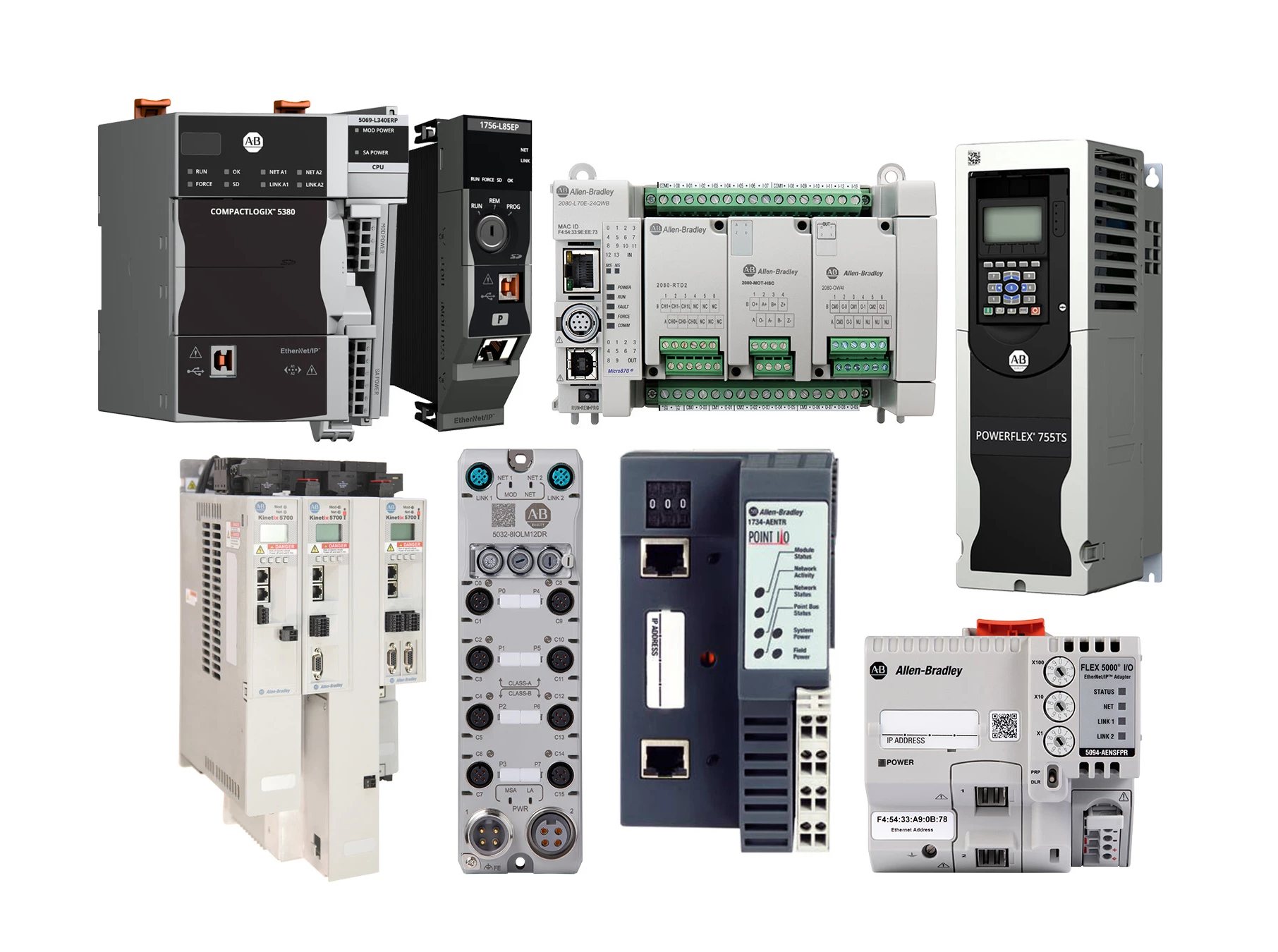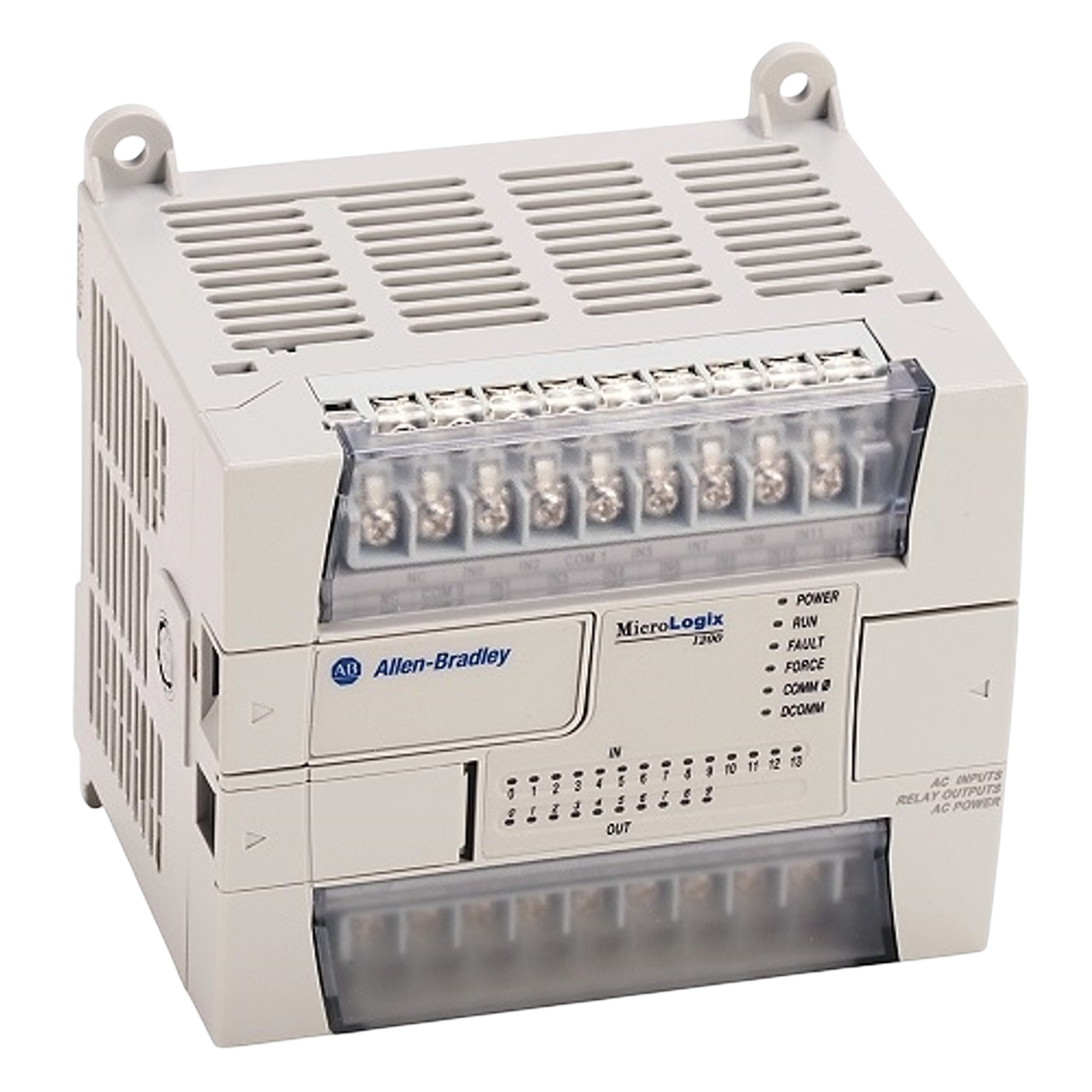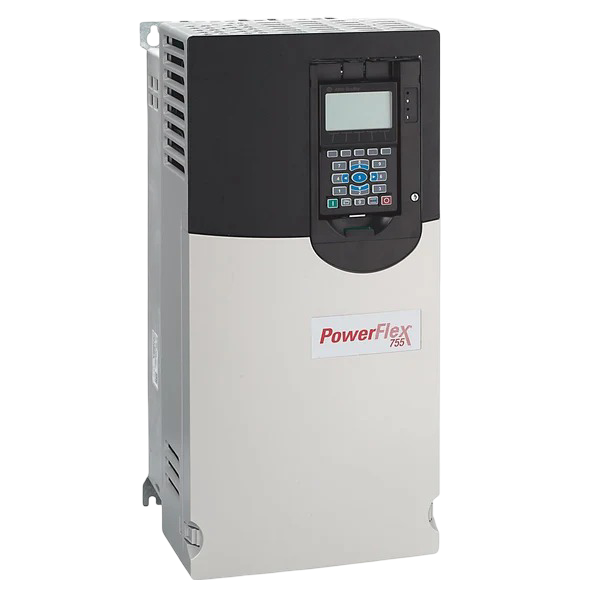Integrating Communication Switches for your Allen Bradley Drives and PLCs

Integrating communication cards and switches into Allen-Bradley PLCs and drives is a critical step in building a reliable, scalable industrial automation network. These components allow Rockwell Automation hardware to communicate across a variety of protocols such as EtherNet/IP, ControlNet, DeviceNet, and legacy serial interfaces—supporting seamless data exchange between controllers, drives, HMIs, and SCADA systems.
Allen-Bradley PLC platforms like CompactLogix and ControlLogix are modular, making it easy to install communication modules such as the 1756-EN2T (EtherNet/IP) or 1756-DNB (DeviceNet) into the backplane. These cards act as gateways, enabling the controller to interface with field devices or higher-level systems. Similarly, drives like the PowerFlex 525 or 755 support communication adapters including the 25-COMM-E (EtherNet/IP) and 20-COMM-D (DeviceNet), which are installed directly into the drive’s communication port. These adapters reduce wiring complexity and allow parameter changes or diagnostics to be managed remotely via Studio 5000 or other software tools.
Industrial Ethernet switches—such as the Stratix 2000 or 5700—play a vital role in structuring the network. Managed switches enable features like VLAN segmentation, IGMP snooping, and Quality of Service (QoS), which optimize traffic for control data and prevent latency. For smaller systems, unmanaged switches may be used where simplicity is preferred over configurability.
A key benefit of using communication cards and switches is unified control. Devices can be synchronized with high-speed I/O and motion commands, while also transmitting diagnostics, energy usage, and predictive maintenance data. Proper network topology and IP address management are essential, especially in larger systems.
Quick Menu
How to Find your Allen Bradley Communication Options
Selecting the right communication options for your Allen-Bradley PLCs and drives depends on your specific hardware, network requirements, and integration goals. Rockwell Automation offers a wide range of communication modules, adapters, and protocols, so narrowing down the right fit starts with identifying your base equipment and application needs.
Start by checking the model of your PLC or drive. For instance, ControlLogix (1756 series), CompactLogix (1769 or 5069 series), and MicroLogix (1100/1400) controllers each support different communication modules. Similarly, PowerFlex drives (like the 523, 525, 753, and 755) offer modular communication options that plug into onboard adapter slots.
Next, determine your network protocol. EtherNet/IP is the most commonly used across Allen-Bradley systems, but you may also encounter DeviceNet, ControlNet, Profibus DP, Modbus, or serial communication needs depending on the legacy systems or third-party equipment you’re interfacing with. Once your protocol is clear, choose the correct module:
| Communication Type | ControlLogix | CompactLogix | MicroLogix | PowerFlex 525 Drives | PowerFlex 70/700 Drives | FLEX I/O (1794 Series) |
| ControlNet | 1756-CN2, 1756-CN2R | — | — | 22-COMM-C | 22-COMM-C | 1794-ACN15 |
| Profibus DP (Master) | MVI56-PDPMV1 | MVI69-PDPMV1 | — | — | — | — |
| Profibus DP (Slave) | MVI56-PDPS | MVI69-PDPS | — | 22-COMM-P | 20-COMM-P | 1794-PDPS (via adapter) |
| Modbus RTU/ASCII (Master/Slave) | MVI56-MCM, MVI56E-MCM | MVI69-MCM, MVI69E-MBS | 1761-NET-AIC (via DF1/RS232) | 22-COMM-M | 20-COMM-M | — |
| EtherNet/IP | 1756-EN2T, 1756-EN3TR | 5069-EN0x, 1769-L3xER | Embedded (EtherNet/IP on 1100/1400) | Embedded EtherNet/IP, 25-COMM-E2P | 20-COMM-E | 1794-AENT |
| DeviceNet | 1756-DNB | 1769-ADN, 1769-SDN | Embedded (MicroLogix 1500 w/1769-SDN) | 22-COMM-D | 20-COMM-D | 1794-ADN |
If Profibus or ControlNet is required, MicroLogix is not the ideal platform. Consider upgrading to CompactLogix or ControlLogix, which support both protocols through dedicated modules.Finally, consider future scalability. If your system will expand, a managed switch like the Stratix 5700 and protocols with high bandwidth (EtherNet/IP) are preferable. Also ensure your chosen cards are compatible with Studio 5000 or RSLogix, depending on your software environment.
How to Modify your Part Number for your Communications Slot

For Allen-Bradley products, the communication option is usually indicated in specific sections of the part number, but it varies by product family. Below is a breakdown for major product lines and how to identify communication-related options in the part number:
ControlLogix (1756 Series)
- Communication modules are distinct part numbers (e.g., 1756-EN2T, 1756-DNB, 1756-CN2).
- The part number itself is the communication module—there’s no embedded communication detail in a CPU’s part number.
Example:
MicroLogix (1100, 1200, 1400, 1500)
- Some communication capabilities are embedded:
- 1100 and 1400 include Ethernet by default.
- Communication modules like 1761-NET-AIC (RS-232/RS-485/DF1) are used for expansion.
- There’s no ControlNet or Profibus-specific code in the base part number.
PowerFlex Drives (e.g., 4, 40, 525, 70, 700, 750 series)
- The drive base part number doesn’t include the communication option.
- Communication is determined by plug-in adapter modules, which can be installed in the field. The digit for the communication option is the 3rd to list.
For example, in the sample part number 20AB2P2A3AYNANC0, The N = no communications card. You can replace this digit with a C for ControlNet, a D for DeviceNet, or an E for Ethernet/IP. Alternatively, you can source the N version with no comms, and then purchase the card separately. Please contact TCI Supply for assistance in this matter
Troubleshooting Communication Options on Allen-Bradley drives and PLCs:
General Communication Troubleshooting
- Verify all modules and adapters are securely seated and powered on
- Check IP addresses, subnet masks, and gateways for conflicts or misconfiguration
- Ensure compatible firmware versions across controller, modules, and software
- Use RSWho (RSLogix) or RSLinx Classic to detect and browse connected devices
- Look for module status LEDs (e.g., OK, NET A/B, Mod, Comm) and interpret blinking patterns
- Cross-reference LED codes with manuals for quick fault diagnosis
EtherNet/IP Specific
- Confirm network cables are Cat5e or better and rated for industrial use
- Avoid duplicate IP addresses—use BootP or static addressing where applicable
- Ping the device from your PC to verify connectivity
- On managed switches, check port status, VLAN settings, and IGMP snooping
- Use Studio 5000’s “Who Active” or RSLinx’s diagnostic tools for live status
DeviceNet
- Check for correct node addresses and unique MAC IDs
- Verify network termination resistors are installed at both ends of the trunk
- Use the 1756-DNB module or DeviceNet scanner to view diagnostic codes
- Inspect power supply voltage on the network (typically 24V DC)
- Look for broken or reversed CAN_H / CAN_L wiring
ControlNet
- Verify BNC cable connections and terminators at both ends
- Use RSNetWorx for ControlNet to verify network health and scheduled bandwidth
- Make sure redundant modules (e.g., 1756-CN2R) are both healthy and synchronized
- Avoid network collisions by maintaining segment distance and grounding integrity
Modbus/Serial
- Confirm correct baud rate, parity, stop bits, and data bits match across devices
- Use ModScan or similar tools to validate signal and polling
- Double-check wiring for RS-232 vs RS-485 (pinout and signal type vary)
- Ensure shielded cable with proper grounding to avoid noise interference
FAQ: Allen-Bradley PLC and Drive Communications

Q: What communication protocol is most common in Allen-Bradley systems?
A: EtherNet/IP is the standard protocol across most Allen-Bradley PLCs and drives, offering high-speed control and diagnostics.
Q: Can I add communication options to my existing PowerFlex drive?
A: Yes, PowerFlex drives support plug-in adapters like 22-COMM-E (EtherNet/IP) or 20-COMM-D (DeviceNet), depending on the model.
Q: How do I know which communication module my ControlLogix system needs?
A: The protocol determines the module: use 1756-EN2T for EtherNet/IP, 1756-DNB for DeviceNet, or 1756-CN2 for ControlNet.
Q: Do CompactLogix controllers have built-in communication?
A: Many models include embedded EtherNet/IP, while others may require separate modules like 5069-EN0TR or 1769-SDN.
Q: Can Allen-Bradley PLCs communicate with Modbus devices?
A: Yes, via ProSoft modules like MVI56-MCM (ControlLogix) or MVI69-MCM (CompactLogix) for Modbus RTU/ASCII integration.
Q: How do I troubleshoot communication loss with a PowerFlex drive?
A: Check the adapter’s status LEDs, verify the communication cable and protocol settings, and use software like Studio 5000 or RSLinx to confirm network visibility.
Q: Are Allen-Bradley drives and PLCs compatible with third-party devices?
A: Yes, as long as the third-party equipment supports compatible protocols like EtherNet/IP, Modbus, or Profibus using the appropriate communication modules or gateways.
Q: What software is needed to configure Allen-Bradley communication modules?
A: Use Studio 5000 for ControlLogix/CompactLogix, DriveExecutive for PowerFlex drives, and RSLinx for network browsing and diagnostics.
